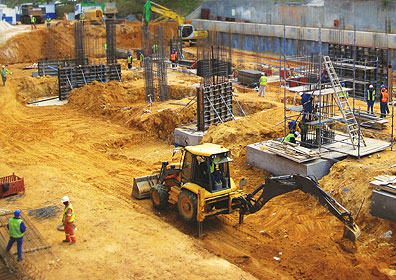Geotechnical Geologist Services for Accurate Soil and Rock Evaluation
Wiki Article
A Comprehensive Assessment of the Providers Supplied by Consulting Engineers in the Area of Geotechnical Engineering: From Website Investigation to Job Application
Consulting engineers in geotechnical design play a critical role in the effective implementation of construction jobs, starting with thorough site investigations that disclose important subsurface conditions. Their know-how prolongs to soil residential property evaluations, environmental influence assessments, and the mindful monitoring of task implementation, making sure placement with safety and security and sustainability standards.Importance of Geotechnical Design
Geotechnical engineering is an important self-control that underpins the security and sustainability of civil infrastructure tasks. By comprehending the mechanical actions of dirt and rock products, geotechnical designers analyze the viability of sites for numerous constructions, consisting of buildings, bridges, and dams. This basic analysis makes certain that frameworks can endure ecological factors and tons without experiencing failing.The value of geotechnical engineering prolongs beyond plain architectural safety and security; it also includes ecological stewardship. Appropriate geotechnical assessments contribute to decreasing the environmental impact of construction. Via mindful examination of soil residential or commercial properties and groundwater conditions, engineers can create foundations and retaining structures that mitigate risks such as disintegration and landslides, promoting long-term stability.
Additionally, geotechnical design plays an important function in job price administration. geotechnical works. By recognizing prospective problems early in the layout phase, designers can recommend suitable remedies, therefore avoiding pricey hold-ups and redesigns throughout construction. This aggressive approach not just boosts project efficiency however likewise dramatically minimizes dangers related to unanticipated site problems
Website Investigation Techniques
Effective website investigation techniques are essential for collecting precise data concerning subsurface conditions before building and construction. These techniques facilitate the understanding of the geological and hydrological atmosphere, which is crucial for ensuring the security and security of suggested frameworks.Usual methods employed in site investigations include borehole drilling, which allows engineers to remove dirt examples at various midsts, providing understandings right into stratification and material types. On top of that, geophysical surveys, such as seismic refraction and electric resistivity, deal non-invasive means to examine subsurface attributes over larger locations. These methods can aid determine anomalies without substantial excavation.
Test pits are one more valuable strategy, offering direct observation of dirt layers and enabling in-situ screening. geotechnical works. This strategy is specifically helpful for superficial excavations and can help evaluate groundwater levels. Cone infiltration tests (CPT) are increasingly made use of, as they offer constant profiles of soil resistance, which assists in establishing soil stamina and layering.
Each of these techniques plays a crucial role in establishing a detailed understanding of site conditions, enabling consulting designers to make informed choices and recommendations throughout the task lifecycle. Exact data collection throughout the site investigation phase is crucial to mitigating risks and guaranteeing successful task execution.
Soil Residential Or Commercial Property Assessment

The analysis process commonly includes a combination of laboratory tests and field investigations. Trick properties such as shear strength, compressibility, leaks in the structure, and wetness material are evaluated to establish the dirt's suitability for building functions. Basic examinations, consisting of the Atterberg restrictions, Proctor compaction, and triaxial shear examinations, are frequently employed to collect information on soil behavior.
In enhancement to these tests, in-situ methods such as the Requirement Penetration Examination (SPT) and Cone Infiltration Test (CPT) offer valuable insights right into dirt stratigraphy and thickness. The outcomes of these analyses notify engineers regarding prospective difficulties, such as dirt liquefaction or negotiation, allowing them to devise proper reduction strategies.
Environmental Effect Assessment
Ecological impact evaluation plays an important duty in the preparation and implementation of design projects, especially in geotechnical engineering. This procedure entails examining the prospective environmental consequences of proposed projects on soil, water, air high quality, and surrounding ecological communities. Consulting engineers use numerous methods, including website evaluations, modeling, and field research studies, to identify and evaluate these impacts.The examination commonly begins with the identification of baseline ecological conditions, which acts as a referral for predicting potential modifications. Designers examine variables such as erosion, groundwater contamination, and habitat disturbance, guaranteeing that all appropriate environmental laws and guidelines are stuck to throughout the task lifecycle. Stakeholder involvement is also an important component of the analysis procedure, as it cultivates communication in between task designers, local neighborhoods, and governing bodies.
Additionally, reduction techniques are developed to attend to recognized influences, enabling engineers to recommend choices or alterations to project layouts that boost sustainability. This aggressive method not just reduces negative results on the environment but additionally promotes public trust fund and conformity with environmental legislation. Inevitably, efficient environmental influence evaluation reinforces the total honesty and stability geotechnical geologist of geotechnical design projects, supporting liable growth practices.
Task Application and Monitoring

Tracking is a necessary element of job execution. Engineers use numerous methods, such as instrumentation and area examinations, to analyze soil actions and architectural responses in real-time. This continuous monitoring makes it possible for the recognition of any type of variances from expected efficiency, enabling for timely treatments to alleviate threats.
Additionally, speaking with designers preserve open interaction with service providers and stakeholders throughout the process. Normal website assessments and report card guarantee that all events are notified concerning task condition and any type of emerging concerns. By promoting collaboration and openness, getting in touch with engineers facilitate an extra reliable application process, thereby boosting job end results.
Eventually, reliable task application and monitoring not just copyright safety and quality standards however additionally add to the overall success of geotechnical tasks, guaranteeing they meet their desired functions sustainably and responsibly.

Final Thought
In verdict, the duty of getting in touch with designers in geotechnical engineering encompasses a critical sequence of services that ensure task success. Eventually, the multifaceted contributions of seeking advice from designers are necessary in dealing with the intricacies of geotechnical obstacles in modern-day design tasks.Report this wiki page